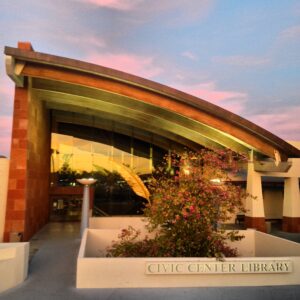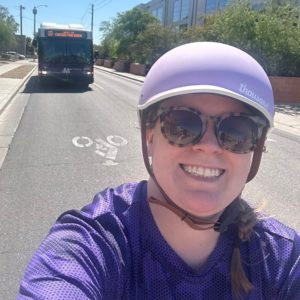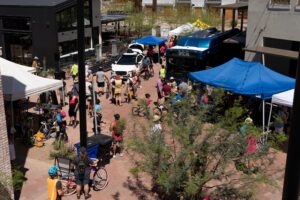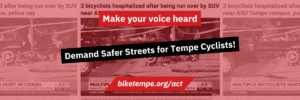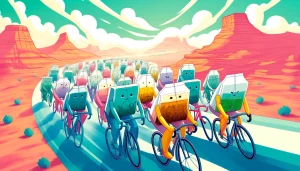Car-free in Tempe (with a toddler!)
Living a car-free lifestyle with children can seem daunting, but for Sarah, it’s a way of life that she embraces with enthusiasm. In our latest Q&A, we sat down with Sarah, a dedicated mother navigating Tempe’s urban landscape without a car, accompanied by her energetic toddler. From her nearly 20 years of being car-free, Sarah shares her experiences and insights, offering a glimpse into a sustainable and fulfilling way of life. Join us as we hear her story and uncover the unique perspectives of a family thriving without four wheels.
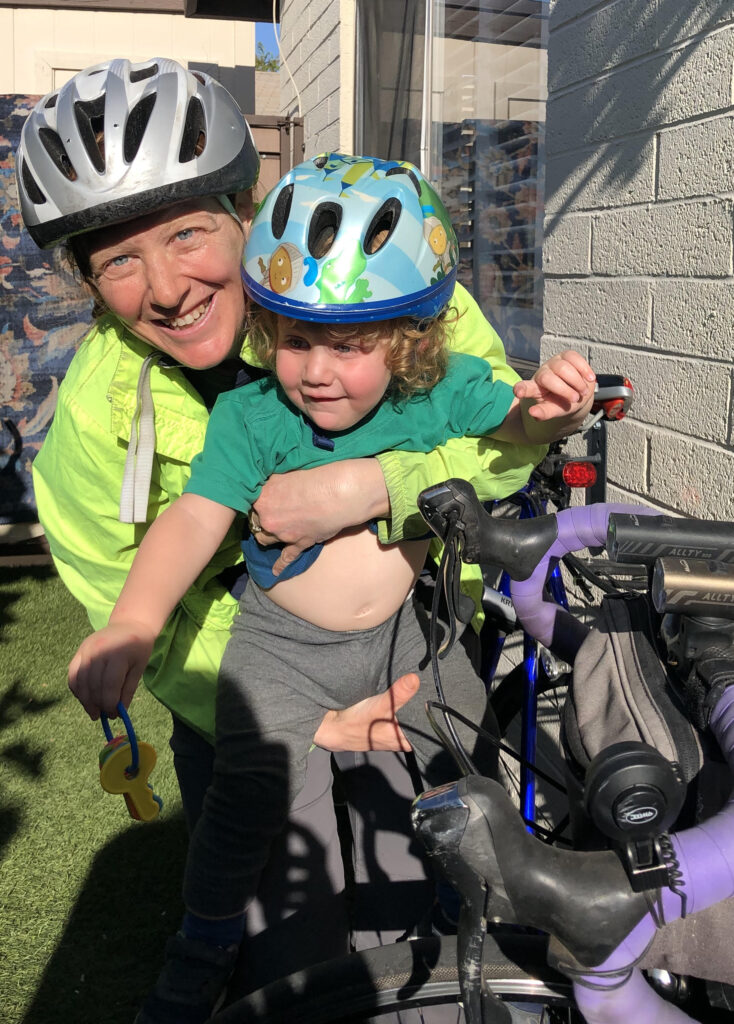
How long have you been car free?
I’ve been car-free since 2006. (A slight caveat here is that my husband, Simon, had a car for a couple of years when we lived in rural Michigan. He worked in the middle of the woods! I rarely used it, but I did occasionally. Part of our deal was that I would always be able to bike to work, no matter what job he decided to take. That meant that we always lived within biking distance of my work, but for those two years, we didn’t live within biking distance of his work.)
Why did you decide to give up your car?
For so many great reasons! In 2006, I was about to start a thru-hike of the Appalachian Trail and then join the Peace Corps. Hiking the AT did not require a car (you just walked or hitchhiked into town when you needed food) and people managed to get around in Namibia (the country I served in from 2006-2007) via an informal taxi/hitchhiking system. Paying for car registration for the three years that I would be hiking/serving in the Peace Corps seemed kind of silly. At that exact moment in time, a good friend who (ironically) had just moved to Tempe for grad school was saying that she felt Tempe was really impossible to navigate without a car. She felt like having a car would make her life a lot better. I kind of felt like having a car was making my life worse, so I just gave her my car. Since then, the benefits have only multiplied. Being car-free improves my mental health, improves my physical health, saves me a ton of money, helps me feel more engaged with my community, and helps me shine light on the largely unexamined assumption that having a car is part of a normal adult life in the US.
How do you get around now?
I mostly use my bike. My husband and I transport our 2-year-old son, Quinn, using a trailer that we attach to our bikes. I should say that the summer afternoons in Tempe are sometimes dangerously hot for babies and very small kids. (The pediatrician recommended that when it gets above 110, it’s basically not safe to be outside for very little kids.) On those days, when we need to transport Quinn in the afternoon, we use the city bus or sometimes we also use Waymo. Morning and evening transport have never been a problem, however, since it’s relatively cooler during those parts of the day. Otherwise, if Quinn is not a factor, Simon and I almost exclusively use our bikes to get around, even in the summer.
What are some unexpected challenges you have faced?
When I lived in Vermont, getting around by bike was challenging in the winter! But, thanks to the bike community, I learned about studded tires for bikes. I felt amazing, cutting through the ice and snow using those tires! When I relocated to Tempe in 2020, I was a little surprised at the gaps in connectivity between, for example, Tempe and Mesa. I worked in Mesa but lived in Tempe. I have to say, I never found a route to work that was less than 12 miles one way that felt very safe to me. Because of this and a few other factors, I ended up taking a job in Tempe and now my commute is much safer. I had never had that kind of problem in other places I’d lived, so it was definitely unexpected. Tempe is surrounded on all sides by very large highways; as a result, slower, more bike-friendly streets rarely cross those highways, leading to gaps in the network of roads that are safest for active transportation users.
How has your life changed for the better?
I think the biggest and most important benefit to my life has been improved emotional resilience and mental health. Because I bike to work and everywhere else, it’s required for me to spend time outside, moving my body, whether I feel like it or not. I’m definitely not the kind of person with enough willpower to go to the gym regularly, so this is the way I make sure that I’m staying active and getting some sunshine. For me, this is a key part of maintaining my mental health. I also save a ton of money. I’d invite readers to use this tool from AAA. I think I probably save at least $8000/year by not owning a car, and that is a conservative estimate. This savings allows me to pursue other passions. Also, if I was not married or living with someone else who was earning money, it might be hard to make ends meet (as well as save for retirement, etc.) on a teacher’s salary, especially with a kid. Without the expense of car ownership, I feel pretty confident that I could keep my service-oriented and meaningful job while still supporting myself and my son, even if I was living on my own. Being car-free helps me feel more independent and self-sufficient. Finally, we have a clear call to do something about climate change. Of course, we need to demand large, systemic change from government and industry. But sometimes, that kind of change feels like it’s not within my power to affect. It can feel really disheartening, especially when I imagine Quinn’s future. Americans contribute more carbon emissions per capita than any other nation in the world. Emissions are steadily rising over the last few decades, and transportation appears to be the biggest driver of these rising emissions. Getting on my bike everyday (or sometimes walking or taking the bus) feels like one way I can personally affect change on this critical issue. Being car-free has helped me live out my values in many ways, including this one. And that makes me a happier, more fulfilled human being.
Do you see the built environment differently than you did before?
Definitely. I’m more aware of gaps in connectivity on smaller, slower roads. I can feel the stress in my body release when I’m on a canal path or a road with a 25 mph speed limit and speed bumps. I also notice how much space we dedicate to parking on our streets– space that could be converted to a protected bike lane.
What advice do you have for people who are curious but hesitant to go car free?
I know a lot of people will test the waters of car-free life by keeping their car for a year or so and trying not to use it very much. I don’t have enough willpower for that, but it seems to work well for a lot of people and is probably a good balanced approach to a major lifestyle shift.
I guess, the best advice I can give that has been most helpful for me over the years is to get plugged into the bike community. A lot of people I meet are really interested in trying to go car-free or car-lite, but they have some concerns. Usually, the things they have trouble getting past are: biking in the heat of the AZ summer, safely biking among cars, looking professional for work, transporting children, and bike breakdowns/flat tires. Their concerns are well-founded. These things have definitely been issues for me, as well. But, for all of these issues and problems, I have found a solution from someone in the biking community. People are so inventive and creative– there is a solution out there and it lives in the hive mind of the folks at Bike Saviours, TBAG, and other bike groups in your area.
For example, staying hydrated in the heat of the summer is tough! But Patrick at Bike Saviours showed me this cool 4-liter tank that fits in the front triangle of your bike. When I was just beginning my car-free journey, a female friend in the bike community helped me make a wardrobe game plan for looking professional– in the summer, I biked to work in leggings and a tank top, and then kept a couple of long flowy skirts and button down shirts in my desk drawer that I threw overtop my biking outfit when I got to work. For bike breakdown issues, I just learned how to fix most things on my bike myself, with a lot of help from the folks at Bike Saviours and other bike collectives. The good news is that this is a totally feasible goal for almost anyone. Bikes can be fairly simple machines. You can’t say the same about fixing most modern cars! Of course, these solutions might not work for your specific case, but there are a million other solutions out there in the bike community.
Anything else you would like to add?
I feel so grateful to live in a place with organizations like TBAG and Bike Saviours. They truly make my car-free lifestyle feasible. We have a really special thing going here with these two organizations right here in Tempe, and I hope more people decide to use these two community resources to subtract some car-time from their lives and add some bike-time! Also, anyone who’s really interested in the nitty gritty of how I make car-free work for me and my family, please shoot me an email at: [email protected]. Happy to answer any questions!
